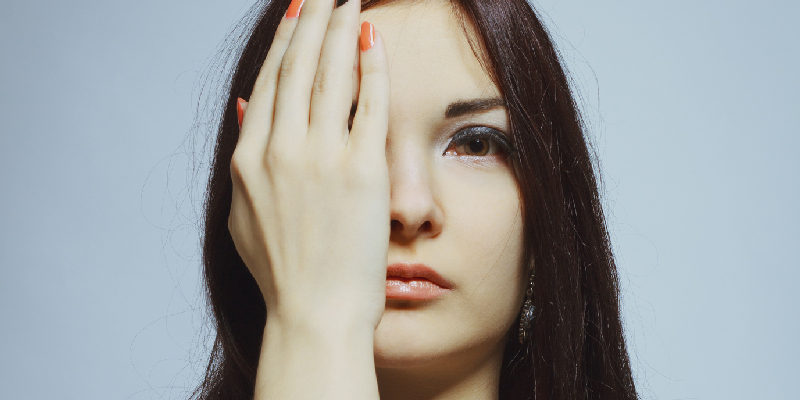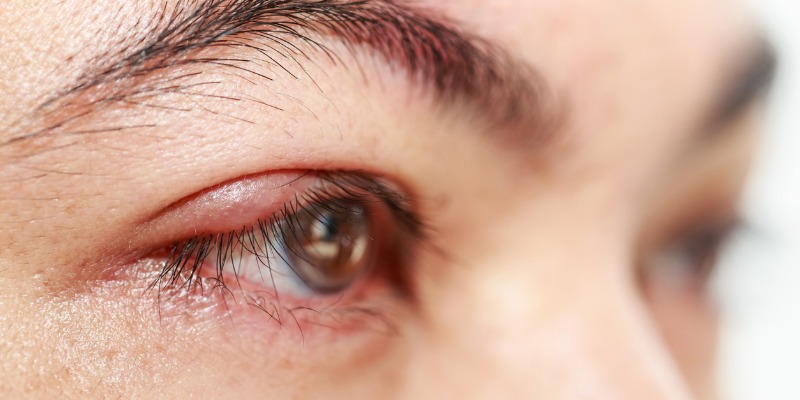Blepharitis is a catchall term for any swelling of the eyelid and can be caused by a number of different problems.
When this swelling is due to inflammation of the meibomian glands, or meibomitis, it is known as posterior blepharitis. The meibomian glands line the edges of your eyelids and secrete the special oil layer that prevents your eyes from drying out and your tears from washing away too quickly.
Meibomitis can occur when these glands become infected, or are irritated or stressed by factors such as pre-existing skin conditions or hormonal imbalance, causing the eyelids to inflame. When this happens, the meibomian glands tend to be clogged by a waxy substance, causing dry eye-related complications, as insufficient amounts of the oily water-seal are being produced.
While this is not usually very serious, it can be rather uncomfortable and unsightly, and if the inflammation gets too severe it can cause damage to the eye.
Easy At-Home Solutions

Quick therapies can be used to treat the symptoms and reduce discomfort in the short term.
Lubricating eye drops, available over-the-counter, can moisten your eyes and decrease irritation associated with dry eye.
Likewise, taking an over-the-counter anti-inflammatory drug such as acetaminophen (Tylenol) or ibuprofen can help reduce swelling and inflammation-related pain.
Chronic, or long-term, posterior blepharitis requires some more stringent measures to clear up the source of the inflammation.
A simple at-home option for posterior blepharitis is to warm the affected eye for five minutes at a time with a warm compress, facial mask, or a washcloth dampened with warm water. This helps soothe the area, encourage blood flow, and can help facilitate unclogging of the meibomian glands.
Gently massaging the upped eyelids downward and the lower eyelids upward while the area is being warmed can also be helpful.
Powerful, But Gentle Wipes that Get Rid of Eyelash Mites
Demodex mites, also known as eyelash mites, have been linked with blepharitis.
A large majority of people have at least some eyelash mites. However, if they get out of control they can contribute to several different ocular conditions, including blepharitis.
Cliradex towelettes have been formulated to help you get rid of these pesky critters and the problems they can cause. Cliradex towelettes contain 4-terpineol. 4-terpineol is a compound of tea-tree oil.
It has been clinically proven to be able to kill Demodex mites and is safe enough to use for the month or so that is needed to eliminate all mites.
The Importance of Blinking and Keeping Your Eyes Clean

The physical act of blinking is important for stimulating tear and meibomian oil production and wiping them across the eyes.
One factor that can contribute to meibomian gland dysfunction is not blinking frequently enough to facilitate proper glandular function and eye lubrication. As people age, they tend to blink less often, and staring at a screen such as a computer monitor can cause you not to blink as often as you should. Therefore, some doctors recommend blinking exercises where you focus on blinking at least 20 times in a row, four times a day, to help improve meibomian oil production and reduce the associated blepharitis.
Keeping your eyes clean is also important in relieving meibomitis.
Unfortunately, the eyes can be tricky to clean properly as they are inset from the nose, brow ridges, and cheekbones. Many doctors recommend washing your eyes with baby shampoo diluted in warm water as a gentle daily cleansing method. This is the old way.
Nowadays, disposable eye wipes or gentle cleansers, such as Cliradex, are more useful as a part of your daily routine to keep your eyes and surrounding skin clean without causing irritation. Cliradex contains 4-terpineol, a compound in tea tree oil, which is effective in eliminating eyelash mites.
Although they also are present on healthy skin, eyelash mites (Demodex) have been linked to blepharitis.
Medication and Other Options

Stronger medicinal interventions may be required if chronic posterior blepharitis does not go away using milder options.
If your doctor suspects an infection, he may prescribe topical antibiotics such as doxycycline, cyclosporine, or azithromycin to kill the pathogens responsible for triggering the inflammatory response.
A topical steroid such as corticosterone may also be prescribed to tackle inflammation that proves difficult to alleviate. The downside to these treatments is that they may be irritating to your eye.
In extreme cases where topical steroids or antibiotics are ineffective, oral steroids or antibiotics, such as doxycycline, tetracycline or minocycline, may be used, though these come with some undesirable side effects as well.
Since clogged meibomian glands are frequently a prime cause of blepharitis or contribute strongly to its symptoms, your doctor may wish to perform a procedure known as either “intraductal meibomian gland probing” or “mechanical meibomian expression.” This is a relatively simple technique that uses a small probe to physically open the clogged meibomian gland, similar to snaking a drain to unclog a sink. This procedure lasts only about 20 minutes, during which the ophthalmologist will anesthetize the area around the eye, and then insert a very thin probe into the duct to remove solidified oils.
Some new therapeutic techniques have come onto the market recently, and show some promise in treating posterior blepharitis, though they have not been fully vetted or adopted by ophthalmologists yet.
One such therapy is “emulsion” eye drops containing oils intended to help clear excess oil buildup.
A similar idea is to supplement with omega-3 fatty acids to change the composition of oils within the meibomian gland to reduce oil buildup.
A new “thermal pulsation system” includes a device that is placed on the eye which can deliver heat and pressure to the underside of the eyelid, while “intense pulse light” (IPL) therapy uses specific wavelengths of light delivered to particular areas of the skin to close blood vessels and stop inflammation from occurring.
As always, consult with your doctor to determine what is the best course of treatment for your particular condition.
Resources:
- Gao, Y.Y; Di Pascuale, M.A; Elizondo, A; Tseng, S.C. 2007. “Clinical treatment of ocular demodecosis by lid scrub with tea tree oil.” Cornea 26(2): 136-143.
- Hun, S.T.H; Woo, D.M; Chong, C.W.K; Liu, Y; Francis, K.E; Shah, S.A; Agar, A; Francis, I.C. 2015. “Utilisation of a Novel Test to Measure Severity and Treatment Efficacy of Posterior Blepharitis.” J. Ophthalmol.
- Qiao, J; Yan, X. 2013. “Emerging treatment options for meibomian gland dysfunction.” Clin Ophthalmol. 7: 1797-1803.
- Toyos, R; McGill, W; Briscoe, D. 2015. “Intense pulsed light treatment for dry eye disease due to meibomian gland dysfunction; a 3-year retrospective study.” Photomed Laser Surg. 33(1): 41-46.




